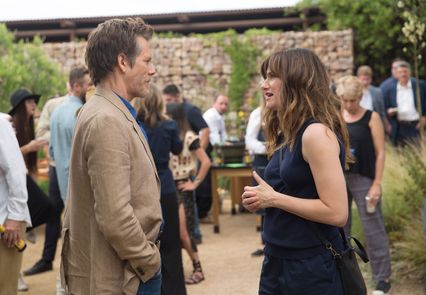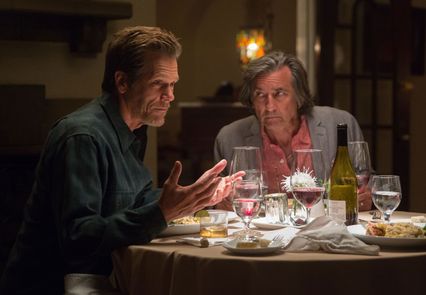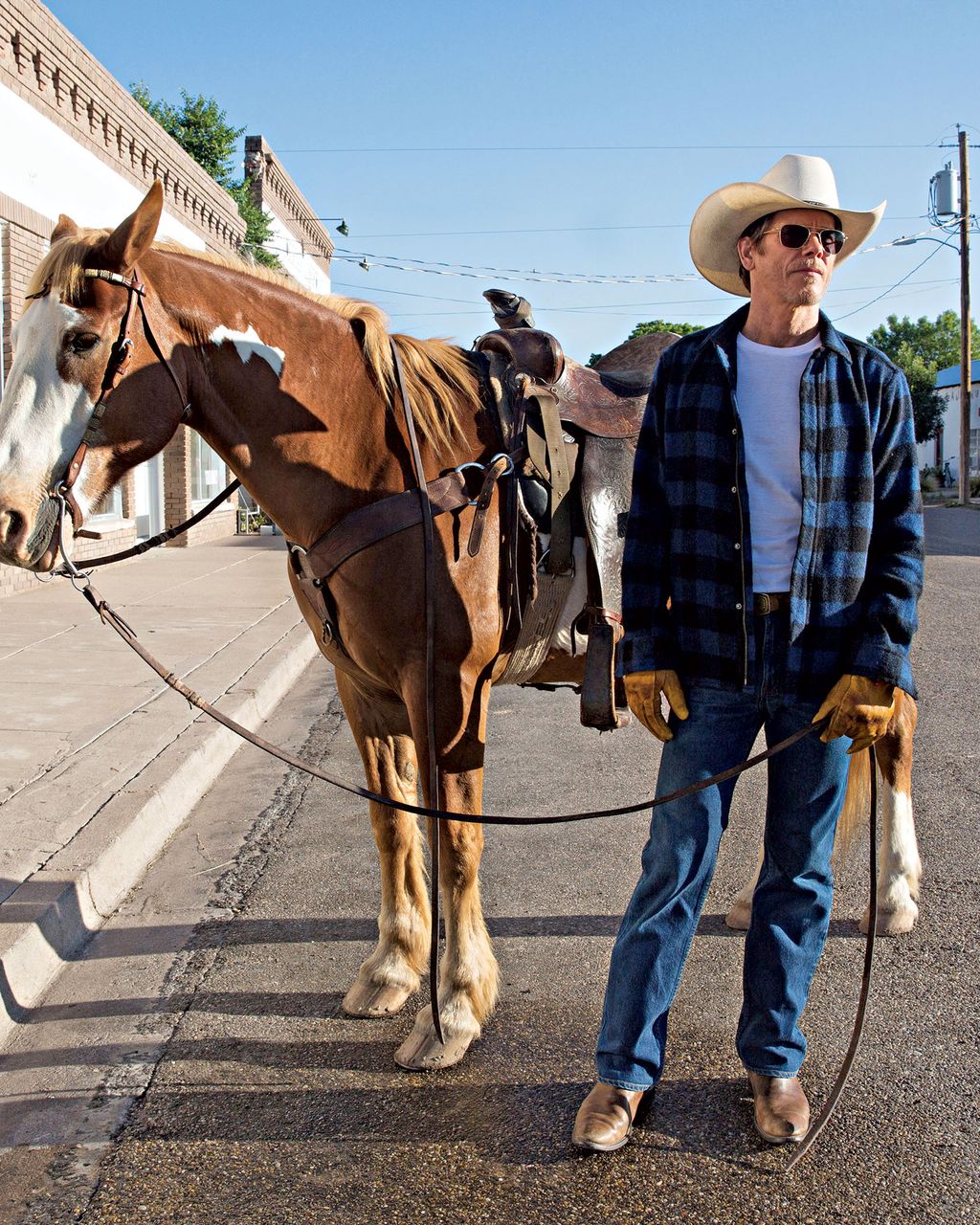It’s a warm day in early June on the Marfa, Texas, set of I Love Dick, Jill Soloway’s new pilot for Amazon, and Kevin Bacon, playing an enigmatic academic named Dick, and Kathryn Hahn, playing a failed filmmaker named Chris, are arguing, over dinner, about the quality of movies made by women. Or, more specifically, about the quality of the films that Chris is, or isn’t, making. Chris’s husband, Sylvère (Griffin Dunne), a cultural critic and Holocaust scholar, keeps his eyes on his rabbit. “It’s a question of desire,” Dick says, “not talent, or timing, or circumstance. Pure want. Which you don’t possess.” He continues, punctuating his mansplaining with a conclusion that might have made even Norman Mailer blush: “Most films made by women ultimately aren’t … that … good.” Shocked and wounded, Chris nonetheless stands her ground. “Women make good shit all the time,” she says. “Jane Campion. Chantal Akerman. Uh, Sally Potter.” With the cameras still rolling, Soloway, who has short salt-and-pepper hair and is wearing hot-pink Nike high-tops, calmly issues direction: “You’re schooling, Kathryn. Educating. Not angry.” Hahn repeats the line, matching Bacon’s disdain with her own defensive hauteur. Soloway smiles.
The 50-year-old Soloway has plenty to feel good about. The I Love Dick pilot begins streaming on Amazon Prime in August, and Soloway’s subversive, Emmy Award–winning series, Transparent, will kick off its third season the following month. Through the production company she runs with Andrea Sperling, Topple (as in “topple the patriarchy”), Soloway has several other provocative projects in the works: her second feature film, Ten Aker Wood, which she wrote and directed, and possible adaptations of two recent, highly acclaimed novels, Dana Spiotta’s Innocents and Others and Cynthia D’Aprix Sweeney’s best-selling The Nest. And assuming the I Love Dick series is greenlit — a fairly safe assumption at this point — she’ll be turning one of the most compelling cult novels of the last 20 years into a television show with the potential to be as groundbreaking in its examination of gender politics as her first.

Translating any book for TV can be like reverse-engineering a magic trick, but I Love Dick might be the least obvious, and most difficult, candidate for adaptation since Game of Thrones. It’s about a romance between a struggling artist and a cultural critic, for one thing, but it’s also sprawling, cerebral, and uncomfortably intimate. Soloway doesn’t shy away from the book’s complexity, however. If anything, she’s attempting to go in the opposite direction, amplifying its themes, adding characters, and pushing it in entirely new creative, geographic, and comedic directions. Just a glance around the set, a fictional, dimly lit restaurant suggestively called the Rope and the Loin, which the art department built in a disused wing of Marfa’s renowned Hotel Paisano, gives a hint of the show’s mash-up of place and perspective: The diverse, largely female crew is mostly from Los Angeles and Austin, the extras a ragtag assortment of Marfans, many older and wearing their best cowboy hats. And then there’s Griffin Dunne, shuffling around in a gray linen suit, pink shirt, and Ugg scuffs, his silver hair almost shoulder length — Bernard-Henri Lévy’s American cousin.
Chris Kraus, a onetime experimental filmmaker and current editor at Semiotext(e), the tiny but influential purveyor of cutting-edge theory and transgressive fiction by the likes of Kathy Acker and Gary Indiana, published the book in 1997. While its plot is reasonably straightforward — girl meets boy, girl becomes obsessed with boy, girl and her husband collude to seduce boy — its self-reflexive, shape-shifting form is anything but. The book’s narrator is also named Chris Kraus, and she is, as Kraus was at the time, a 39-year-old filmmaker married to a Columbia professor and literary theorist named Sylvère Lotringer, also the founder of Semiotext(e). At the book’s opening, as they did in real life, Chris and Sylvère have dinner with a rugged English culture critic named Dick in Pasadena. Dick seems to flirt with her, and Chris develops an unrequited crush. The book chronicles that infatuation — much of it unfolds in a series of love letters — but also, more important, the parallel discovery of Chris’s artistic voice.
In its metafictional misdirection, deadpan comedy, and pitiless interrogation of desire, I Love Dick anticipates much so-called autofiction of the last few years, from Knausgaard to Ben Lerner’s novels and Sheila Heti’s How Should a Person Be? “It couldn’t be called memoir or nonfiction or autobiography,” Heti says of first reading Kraus’s book, “but it wasn’t an essay, nor was it fiction. It seemed to be a form I hadn’t encountered before, and a persona I hadn’t encountered before.” In the book, Kraus describes the genre she’s creating as “Lonely Girl Phenomenology.”
Many of I Love Dick’s admirers — who include Rick Moody and Rachel Kushner — loved its eggheaded name-dropping and appetite for literary and cultural gossip. One reader, not so much. Dick was based on Dick Hebdige, the former CalArts professor and author of Subculture: The Meaning of Style and a friend of Lotringer’s. A 1997 story about I Love Dick in this magazine, which outed him as the inspiration for the womanizing, boozing Dick, reported that he had initiated legal action against Kraus (which was dropped). The book, he said, was “beneath contempt.”
Soloway and playwright Sarah Gubbins, who wrote the teleplay, read I Love Dick for the first time last year, partly as inspiration for a feature film about romantic obsession they’d been developing. But the book was so beguiling they put the film temporarily on hold and optioned I Love Dick instead. As Soloway explained in a suite at the Paisano before the day’s shoot got under way, she identified intensely with Kraus’s decision to use her own name, biography, and, as Soloway put it, her “horribleness.” It helped her, she says, to reframe the shame she herself once felt about her TV writing: “I don’t know how to write about anything other than myself. I can’t write about dragons, I don’t care about crime, I don’t want to write a hospital show. I only want to write about somewhat unlikable Jewish women having really inappropriate ideas about life and sex.” Kraus, for her part, was thrilled that Soloway was interested. “Jill has a great sense of comedy,” she says. “That’s the first affinity. And, of course, the feminism of the book is in sync with her and Andrea’s work with Topple.”
Kraus was also delighted by who was cast as her quasi-fictional alter ego. In the book, Chris’s self-consciousness is tempered by a quicksilver wit; Hahn, best known recently as Rabbi Raquel on Transparent, adds a layer of screwball charm. When Hahn read the book, it had as much personal resonance for her as it did for Soloway: “It punched me in the gut,” she says. “What I appreciated was that idea of just trying to own a voice. I’m 43, and it’s still a very difficult thing to be like, ‘Who am I?’ ” Bacon and Dunne, meanwhile, were both nudged toward the project by the women in their lives. “I was telling my daughter, who’s in her early 20s, about it,” says Dunne, “and I get three sentences into the synopsis and she goes, ‘This is I Love Dick!’ And then she says” — his voice drops dramatically — “ ‘You’re Sylvère.’ ”
The poet and novelist Eileen Myles, who is Soloway’s girlfriend, is also an old friend of Kraus’s. Myles bought a house in Marfa last year, and it was her idea to transplant the story — which largely takes place in Southern California, upstate New York, and Chris’s own head — to the tiny Texas town. Soloway was initially reluctant — “My first thought was, Are you crazy? You think I’m moving my TV show to your town just because we’re dating?” — but she fell in love with the place. A three-hour drive southeast of El Paso, with a population that hovers between 1,500 and 2,000, Marfa was practically a ghost town until the early ’70s, when the conceptual artist Donald Judd transformed its old military fort into an outdoor museum and his own live-work compound. It has since become a near-mythic destination for art aficionados around the world. Mostly because of its relative seclusion and punishing landscape, its subsequent gentrification has proceeded glacially; for every boutique hotel and espresso bar there’s a rattlesnake in your Birkenstock. During the day, the light can be unbearably stark or as golden as popcorn butter; at night, there are few skies as full of stars.
Marfa was a magical interzone that opened up all kinds of creative possibilities. “It was this other piece of the show that we were searching for,” Gubbins says. “Which was a place that was isolated but which could also hold all these different factions: border patrol, a Mexican-American community, ranchers, cowboys, artists, drifting wandering hipsters from L.A. and New York.” Several movies have been shot on the ranchland around Marfa — Giant, There Will Be Blood, No Country for Old Men — but I Love Dick is the first film or TV show that regularly name-checks or uses the city’s actual locations, from the beloved Food Shark food truck (see Beyoncé’s Tumblr) to the Marfa Lights, mysterious glowing orbs that people have spotted on the city’s outskirts since the 1800s.

Along with the story, and much of her usual Transparent crew, Soloway’s imported her normal working methods. The set is characteristically inclusive, chill, and collaborative. Partners, spouses, and children are everywhere. The mobile bathrooms are gender-neutral, and each morning begins with a ritual called “Box,” during which Soloway climbs atop an apple box and makes a brief inspirational speech to the assembled cast and crew. “We get to play, like children,” she says, “by making art. Nobody has to worry about getting anything wrong.” She then invites others to say whatever they like. On this morning, after a couple of crew members follow her, a middle-aged extra named Elizabeth, who works at the local bank, climbs on the box and says she wants to thank everyone “for how y’all make us feel in this town. Thank you for making us feel good.”
Opened in the 1930s, the Art Deco–style Paisano was the place that James Dean, Elizabeth Taylor, and Rock Hudson stayed for two weeks while shooting Giant, George Stevens’s 1956 ranching-and-oil epic. The Rope and Loin’s Western kitsch — Navajo rugs, stuffed stag heads mounted on the walls — and Bacon’s Dick, a rangy cowboy-intellectual in Levi’s, boots, and a dark plaid shirt, conjure an alluring masculinity. On set, the characters Chris and Sylvère, overdressed and edgy, look like they took a wrong turn at Austin. When they sit down, Dick stands to pull out Chris’s chair; unused to such chivalry, she says, with a tight laugh, “Don’t yank it away and make me fall on my ass.” Dick doesn’t smile. When the conversation turns to filmmaking, Dick appears to bond with Sylvère over Chris’s artistic inadequacy. “Is she any good?” Dick asks Sylvère. “You’re good. You can discern.”
A couple of hours earlier, Soloway, still working on a takeout breakfast of bacon and eggs, had been huddled with Gubbins and her regular director of photography, Jim Frohna, in a quiet corner of the Paisano, mapping out the camera angles and choreography of the dinner scene. It was the “heart of the show,” Soloway says, the catalyzing moment for the journey of self-realization Chris would go on. The conversation was spirited, high-minded, and abstract, with much talk about femininity and the male gaze, but it came down basically to viewpoint — who was seeing what and by whom, who was telling what and to whom, whose story was being told and by whom. When Soloway came up with a bit of inspired blocking — Chris announces that she’s going to take Dick’s seminar and then sits down at the same time as he stands up, signifying a transfer of power — she and Gubbins started hopping around, doing a little happy dance. Chris was refusing to be silent, to be objectified, to be told whom she could love and what she could write about. “It’s just so powerful for a woman to say, ‘No, I’m not the object of your story,’ ” Soloway says. “I’m not either the Madonna or the whore, I’m not either the woman that you love or the woman that you hate. I’m the subject. Just that simple sentence is enough to upend the entire planet.”
****
I Love Dick premieres August 19 on Amazon Prime.
*This article appears in the July 25, 2016 issue of New York Magazine.
Opening Photo: Courtesy of Amazon Studios
